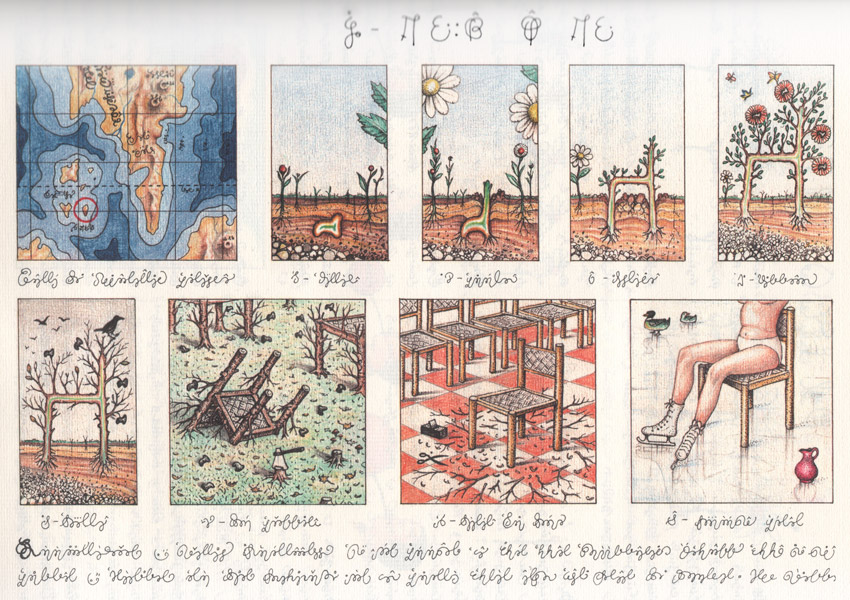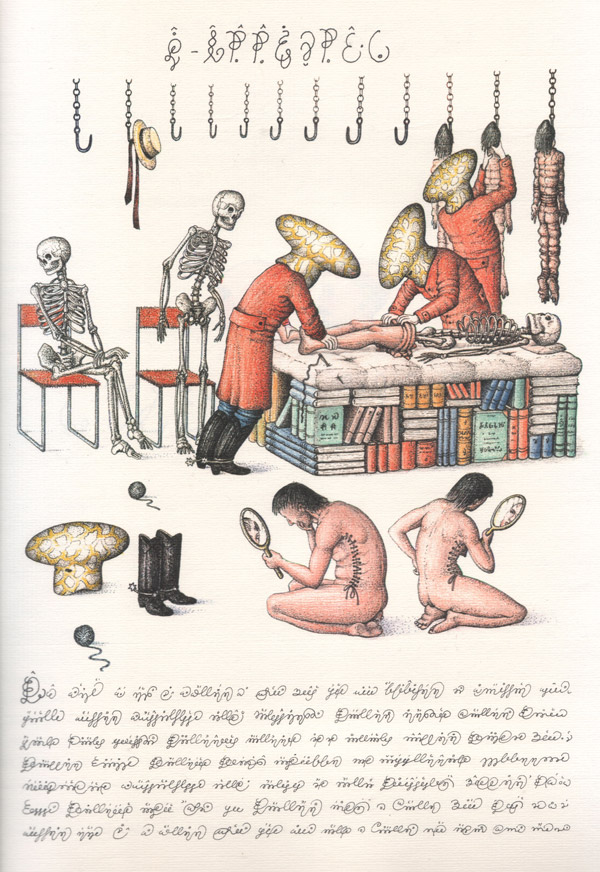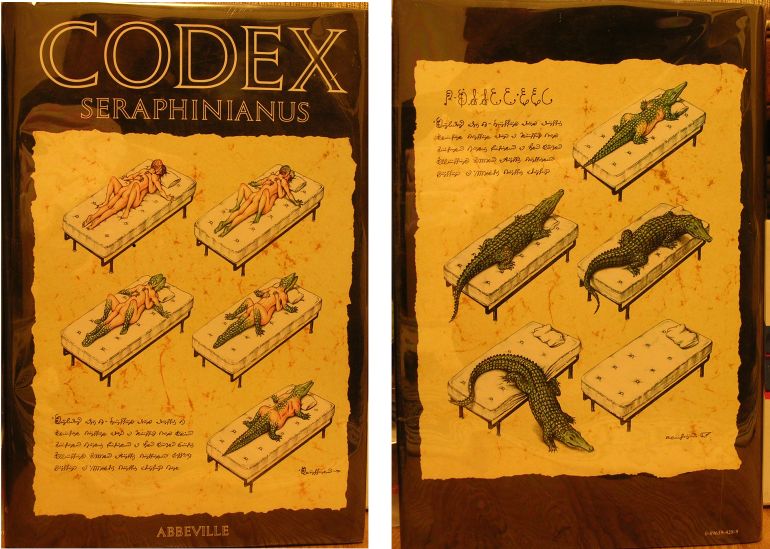
|
|||
Codex Seraphinianus - The World's Weirdest Book
Source : en.wikipedia.org/wiki/Codex_Seraphinianus
Some people think it's one of the weirdest books ever published. An art book unlike any other art book. A unique and disturbing surreal parody. Grotesque and beautiful. It's very hard to describe. Codex Seraphinianus by Italian artist Luigi Serafini is a window on a bizarre fantasy world complete with its own unique (unreadable) alphabet and numerous illustrations that borrow from the modern age but veer into the extremely unusual. Codex Seraphinianus, originally published in 1981, is an illustrated encyclopedia of an imaginary world, created by the Italian artist, architect and industrial designer Luigi Serafini during thirty months, from 1976 to 1978. The book is approximately 360 pages long (depending on edition), and written in a strange, generally unintelligible alphabet. Originally published in Italy, the book has since been released in a number of different countries. The word "Codex" in the title means "book" or "code" (from Latin caudex), and "Seraphinianus" is derived from the author's last name, Serafini (which in Italian, refers to the seraphs). Literally, Codex Seraphinianus means Serafini's code. It was first published in two volumes by Franco Maria Ricci in 1981. The pictures in this AbeBooks article are from the 1983 American edition published by Abbeville - 370 pages of the Twilight Zone. There is also a 1993 single volume edition and a revised 2006 Italian edition with new illustrations - this final edition is the most affordable version. Created in the late 1970s, the book's blurb on the cover flap talks about Codex Seraphinianus being a book for the "age of information" where coding and de-coding messages is increasingly important in genetics, computer science and literary criticism. "The Codex presents the creative vision of this time..." goes on the blurb. If Serafini was so influenced by "information" in the 1970s to create this maverick art book, then what must he make of today's information age? Codex Seraphinianus Covers featuring Facebook, Twitter, blogs and Google? Countless websites and blogs can be found pondering the meaning of Codex Seraphinianus or simply admiring a truly original piece of art/fantasy/imagination - call it what you will. The cover alone is worth studying. The 1991 Abbeville edition features a couple having sex and being transformed into a crocodile. Shakespeare described sex as the "beast with two backs" but Serafini is operating on a different level to the Bard. The 1993 edition uses a different image for its cover - a man in very unpractical headwear appears to be riding a llama, which has an impressive set of antlers. They are both staring into a mirror outside a stone building that appears to be offering some sort of brightly colored food. Both covers are strange but the crocodile sex image is more disturbing. Essentially an encyclopedia about an alien world that clearly reflects our own, each chapter appears to deal with key facets of this surreal place, including flora, fauna, science, machines, games and architecture. It's difficult to be exact because no-one has ever understood the contents page. Elements of today's world are visible but they are nearly always given some surreal twist - floating flowers, a peeled banana containing pills, a strange car covered in flies, clothing that would seem strange even in the 1970s, a man wearing roller-skates - with a fountain pen's nib instead of a hand - stabbed through the chest with a pen, and lots of biped creatures with human legs attached to all manner of crazy things.
The book is an encyclopedia in manuscript with copious hand-drawn colored-pencil illustrations of bizarre and fantastical flora, fauna, anatomies, fashions, and foods. It has been compared to the Voynich manuscript, "Tlön, Uqbar, Orbis Tertius", and the works of M.C. Escher and Hieronymus Bosch. The illustrations are often surreal parodies of things in the real world: bleeding fruit; a plant that grows into roughly the shape of a chair and is subsequently made into one; a lovemaking couple that metamorphoses into an alligator; etc. Others depict odd, apparently senseless machines, often with a delicate appearance, kept together by tiny filaments. There are also illustrations readily recognizable, as maps or human faces. On the other hand, especially in the "physics" chapter, many images look almost completely abstract. Practically all figures are brightly coloured and rich in detail. Baird Searles, in Asimov's Science Fiction (April 1984), says "the book lies in the uneasy boundary between surrealism and fantasy, given an odd literary status by its masquerade as a book of fact".Douglas R. Hofstadter, in Metamagical Themas: Questing for the Essence of Mind and Pattern, finds many of the illustrations "grotesque and disturbing" and others "extremely beautiful and visionary". He says the book "seems to [many people] to glorify entropy, chaos, and incomprehensibility". American journalist Jim Dwyer finds that the work is an early critique of the Information Age.  Codex Seraphinianus Writing system The writing system (possibly a false writing system) appears modeled on ordinary Western-style writing systems (left-to-right writing in rows; an alphabet with uppercase and lowercase letters, some of which double as numerals). Some letters appear only at the beginning or at the end of words, a feature shared with Semitic writing systems. The curvilinear letters of the alphabet are rope- or thread-like, displaying loops and even knots, and are somewhat reminiscent of Sinhala alphabets. The language of the book has defied complete analysis by linguists for decades. The number system used for numbering the pages, however, has been cracked (apparently independently) by Allan C. Wechsler and Bulgarian linguist Ivan Derzhanski, among others. It is a variation of base 21. In a talk at the Oxford University Society of Bibliophiles held on 11 May 2009, Serafini stated that there is no meaning hidden behind the script of the Codex, which is asemic; that his own experience in writing it was closely similar to automatic writing; and that what he wanted his alphabet to convey to the reader is the sensation that children feel in front of books they cannot yet understand, although they see that their writing does make sense for grown-ups.  Codex Seraphinianus Contents The Codex Seraphinianus is divided into eleven chapters, partitioned into two sections. The first section appears to describe the natural world, dealing with flora, fauna, and physics. The second deals with the humanities, the various aspects of human life: clothing, history, cuisine, architecture and so on. Each chapter seems to treat a general encyclopedic topic. The topics of each separate chapter are as follows:
There are a few lines of text written in Codex Seraphinianus in French on two plates in the sixth chapter. It is a quote from Marcel Proust's "A la recherche du temps perdu: Albertine disparue" (In Search of Lost Time: Albertine Gone). The words scattered on the floor of the picture are from the same book. Submit News/Videos/Links | Discuss article | Article Link | More Unsolved and Unexplained Mysteries |
More can be addded on request. Direct your requests at vinit@theunexplainedmysteries.com
